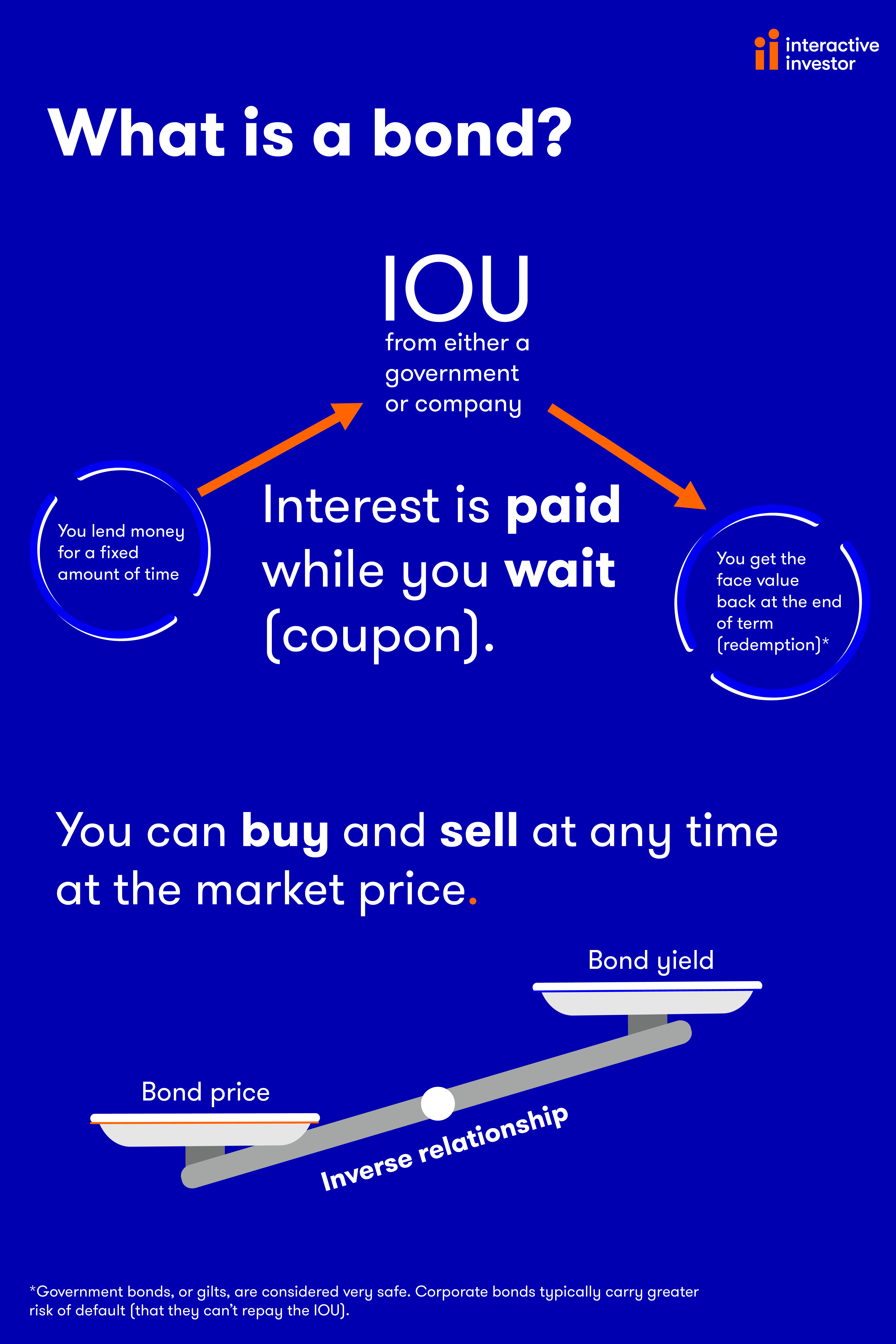Why bonds are back as a diversifier despite rate rises
5th July 2022 09:29
by Ceri Jones from interactive investor
Plenty of commentators argue that the 60/40 portfolio model is broken and potentially outdated. Ceri Jones explains why the role of bonds as a defensive asset will continue to hold its own in the coming years.

Bonds have been falling in line with shares this year, failing miserably in their traditional role as a source of uncorrelated returns.
The situation is about to get a whole lot worse because bond prices tend to fall when interest rates rise, and central banks have been hiking rates furiously to dampen sky-high inflation. The Federal Reserve raised rates by 75 basis points in June, its biggest jump since 1994. Other central banks followed, though not by such colossal amounts. With US inflation at a four-decade high of 8.6%, Federal Reserve policymakers now predict further hikes through the year and into 2023.
A starting point to build a diversified portfolio is to split 60/40 equities to bonds, in an attempt to ensure that some of the assets always hold their value. However, recently both sets of assets have plummeted simultaneously, which has led plenty of commentators to question whether this split has become outdated.
Bond yields on the rise
However, when bond prices fall, yield levels become much more attractive for income-hungry investors. US Treasury yields with a 10-year maturity currently hover at 2.9%, and are probably on their way to 4%. This could appeal to the growing numbers of older people looking for a secure income, particularly as higher rates and monetary tightening are making the outlook for equities more precarious.
“The turn in the rates cycle and central bank reversal of quantitative easing (QE) bond-buying programmes suggests that bond investments will start to offer a better safety net against equity market volatility,” says Bryn Jones, lead manager of Rathbone Ethical Bond fund, a member of interactive investor’s Super 60 and ACE 40.
- Why bonds are at a major turning point, according to veteran investors
- Why bonds are back after a record-breaking sell-off
“Since the financial crisis, low rates have contributed to most equity markets rising consistently, while QE pushed bond prices up and their yields down. Now that rates are rising and QE is being reversed, bonds and equities have been selling off at the same time. But when the ultra-low yields and QE programmes are unwound, I believe bond price movements will once again uncouple from equities, offering protection when stocks fall.”
A year or two out, the question is whether the recession will be so deep that interest rates have to be cut sooner than anticipated, which could cause bond yields to fall again and bond prices to rise.
Recession on the cards – how bonds will respond
Mike Riddell, head of macro unconstrained fixed income at Allianz Global Investors, explains: “For the first time in over two years, we believe that bond yields will likely move lower over the medium to long term as our base case scenario is a global recession, where central banks’ policy of demand destruction creates spare capacity, and reduces inflationary pressure, meaning central banks don’t hike rates anywhere near as much as implied and potentially even cut rates aggressively in 2023.”
Ariel Bezalel, fund manager of Jupiter Strategic Bond, a Super 60 fund, agrees that high inflation will ease. He points out: “We are already seeing clear signs that core inflation is peaking. A combination of the price squeeze that is hurting consumers, tighter monetary and fiscal policy, and economic turmoil in China will see growth slow.
- Bond funds under the cosh: why you shouldn’t write them all off
- The investments that will keep growing – even during a recession
“Recession risk has risen materially in the US, and even more so in Europe. Given how far yields have moved we think government bonds look extremely attractive here, both in absolute terms and as a diversifier going forward, and when markets start to appreciate the extent of the growth slowdown heading our way, a rapid repricing may ensue.
“We are forecasting some further volatility in assets exposed to economic weakness as recession risk gets priced, such as high yield bonds, so we’re keeping some dry powder, but as that volatility comes through there are going to be fantastic opportunities to buy companies at prices not seen in a generation.”
Bond investors turning more bullish
Investors have already been trickling back into corporate bonds, believing prices have fallen to levels that are attractive compared with rich stock prices. Such bonds are yielding around 4.4%, compared with 1.9% last year.
Edward Craven, a fixed interest fund Manager at Invesco, argues the bond market is “deep and broad enough to find opportunities in less well researched corners”.
He adds: “Currently, for example, the sterling investment grade bond market yields 3.7%, on UK Gilts the yield is 2.1%. While considerably higher than a year ago when yields were 1.9% and 0.8% respectively, there are higher yields available elsewhere, either without taking too much additional credit risk or in less interest rate sensitive areas.”
The Invesco Distribution UK fund, which Craven is co-manager, has allocations to the junior debt of banks and insurers, of around 22% of the portfolio, with an average yield of 5.7%. This debt is riskier than senior debt, which is why higher yields are offered to compensate.
- Don’t be shy, ask ii….why is this inflation-linked bond fund losing money?
- Don’t be shy, ask ii...why do some bond funds have such high yields?
Fidelity has been getting more bullish on government bonds and investment grade corporate bonds of late. “For those investors who have been underweight the asset class, we are posing the question: If not now, when will you look to address this underweight?”, says Tim Foster, portfolio manager of the Fidelity Strategic Bond Fund.
He adds: “A defensive asset class that offers income is an attractive proposition at this stage in the economic cycle.”
A tactic to navigate the bond storm is to back active managers who have the flexibility to steer their portfolios to the right bond exposures at the right time. Funds in the strategic bond sector can mix and match any type of bond, such as government bonds, investment-grade corporate bonds and high-yield bonds. Other bond funds are more constrained in that they can invest only in a specific part of the bond market. In interactive investor’s Super 60 list of rated funds, flexible bond options include the M&G Global Macro Bond and Jupiter Strategic Bond.
Bond proxies
Some multi-asset funds have turned to alternatives, such as property and infrastructure, as ‘bond substitutes’. Specialist REITs in areas such as healthcare, office space, warehousing and even casinos often involve leases to operators on long and inflation-linked contracts.
Supermarket Income REIT (LSE:SUPR), for example, yields 5%, and has counterparties such as Tesco (LSE:TSCO), while Impact Healthcare REIT (LSE:IHR)yields 5.5%.It owns a portfolio of 126 care homes.
- Property or infrastructure: which is the best portfolio diversifier?
- Don’t be shy, ask ii…what are the alternatives to bonds?
Infrastructure trusts tend to focus either on social projects, such as HICL Infrastructure (LSE:HICL) and International Public Partnerships (LSE:INPP), or renewable energy such as JLEN Environmental Assets (LSE:JLEN) and Renewables Infrastructure Group (LSE:TRIG). There’s also specialist wind and solar energy trusts such as Greencoat UK Wind (LSE:UKW) and Next Energy Solar Fund.
Liquidity can be a problem for any publicly quoted investment, and particularly for REITs. The other issue with publicly traded stocks is that when stock markets lose faith, a falling tide sinks all ships.

These articles are provided for information purposes only. Occasionally, an opinion about whether to buy or sell a specific investment may be provided by third parties. The content is not intended to be a personal recommendation to buy or sell any financial instrument or product, or to adopt any investment strategy as it is not provided based on an assessment of your investing knowledge and experience, your financial situation or your investment objectives. The value of your investments, and the income derived from them, may go down as well as up. You may not get back all the money that you invest. The investments referred to in this article may not be suitable for all investors, and if in doubt, an investor should seek advice from a qualified investment adviser.
Full performance can be found on the company or index summary page on the interactive investor website. Simply click on the company's or index name highlighted in the article.